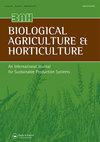Ancient varieties can help control weed density while preserving weed diversity
IF 1.6
4区 农林科学
Q3 AGRONOMY
引用次数: 0
Abstract
ABSTRACTWeeds are a major component of agricultural diversity affecting crop yield and ecosystem services. Compared to modern wheat (Triticum aestivum) varieties, ancient wheat cultivars (released before 1960) are taller, and this trait can be used to control weeds in organic farming systems. However, there is still a lack of quantitative assessments of the relative contribution of wheat breeding-history (ancient vs modern varieties) and synthetic inputs in explaining weed density and community structure. In this study, a field experiment was undertaken where five modern and five ancient wheat varieties were either treated as in a conventional system with synthetic inputs (nitrogen, herbicide and fungicide) or as in an organic system without the use of synthetic inputs. Crop light interception and weed density were recorded for 12 weeks until crop maturity. On average, ancient varieties reduced weed density by 17% compared with modern varieties, while the application of chemical inputs was responsible for an average reduction of 37%. The stronger competitive effect of ancient varieties was associated with increased sunlight interception. Species richness was higher in the absence of inputs for some weeks, but not by the end of the experiment. The field-based results illustrated that ancient varieties can be used to help control weed density in organic systems that do not rely on synthetic inputs for weed control Despite this effect of crop interference on weed density, a reduction in weed diversity was not observed. These findings could be of particular interest to promote agrobiodiversity in agricultural systems without synthetic inputs.KEYWORDS: Ancient and modern varietiescrop heightcrop interferencelight interceptionsynthetic chemical inputsweed community AcknowledgmentsThe authors thank L’Institut Agro Dijon for experimental facilities and the Argentina-France Agriculture Program (ARFAGRI) for the funding of travel costs of Ana Ailén Federico. They are grateful to Graines de Noé for providing the seeds of ancient varieties, especially Hélène Montaz for her advice to select the varieties. They also thank RAGT Semences, Secobra, Saaten Union and Limagrain for providing the modern varieties.Disclosure statementNo potential conflict of interest was reported by the authors.Data availability statementThe data supporting the results are archived in Zenodo, DOI: 10.5281/zenodo.8428384Supplementary materialSupplemental data for this article can be accessed online at https://doi.org/10.1080/01448765.2023.2270982Additional informationFundingL’Institut Agro Dijon for experimental facilities and the Argentina-France Agriculture Program (ARFAGRI) for the travel costs.古老的品种可以帮助控制杂草密度,同时保持杂草多样性
摘要杂草是影响作物产量和生态系统服务功能的农业多样性的重要组成部分。与现代小麦品种(Triticum aestivum)相比,1960年以前发布的古代小麦品种更高,这一性状可用于有机农业系统中的杂草控制。然而,在解释杂草密度和群落结构方面,还缺乏对小麦育种历史(古代品种与现代品种)和综合投入的相对贡献的定量评估。在这项研究中,进行了一项田间试验,其中五个现代小麦品种和五个古代小麦品种分别在常规系统中使用合成投入物(氮、除草剂和杀菌剂)或在有机系统中不使用合成投入物进行处理。记录作物截光量和杂草密度12周,直至作物成熟。平均而言,与现代品种相比,古代品种减少了17%的杂草密度,而化学投入的使用平均减少了37%。古品种较强的竞争效应与增加的阳光拦截有关。在几周没有投入的情况下,物种丰富度更高,但在实验结束时却没有。基于田间的结果表明,在不依赖合成投入的有机系统中,古老品种可以帮助控制杂草密度,尽管作物干扰对杂草密度有影响,但没有观察到杂草多样性的减少。这些发现对于在没有合成投入品的农业系统中促进农业生物多样性可能具有特别的意义。作者感谢第戎农业研究所提供的实验设施和阿根廷-法国农业计划(ARFAGRI)为Ana ail Federico提供的旅费。他们感谢谷物协会为他们提供了古老品种的种子,特别是h l蒙塔兹为他们提供了选择品种的建议。他们还感谢RAGT Semences、Secobra、Saaten Union和Limagrain提供的现代品种。披露声明作者未报告潜在的利益冲突。数据可用性声明支持结果的数据存档于Zenodo, DOI: 10.5281/ Zenodo。8428384补充材料本文的补充数据可在https://doi.org/10.1080/01448765.2023.2270982Additional上在线获取informationFundingL’institut Agro第戎的实验设施和阿根廷-法国农业计划(ARFAGRI)的旅行费用。
本文章由计算机程序翻译,如有差异,请以英文原文为准。
求助全文
约1分钟内获得全文
求助全文
来源期刊
CiteScore
3.30
自引率
6.70%
发文量
18
审稿时长
>36 weeks
期刊介绍:
Biological Agriculture & Horticulture aims to act as the central focus for a wide range of studies into alternative systems of husbandry, and particularly the biological or organic approach to food production. The Journal publishes work of a sound scientific or economic nature related to any aspect of biological husbandry in agriculture, horticulture and forestry in both temperate and tropical conditions, including energy and water utilization, and environmental impact.

 求助内容:
求助内容: 应助结果提醒方式:
应助结果提醒方式:


